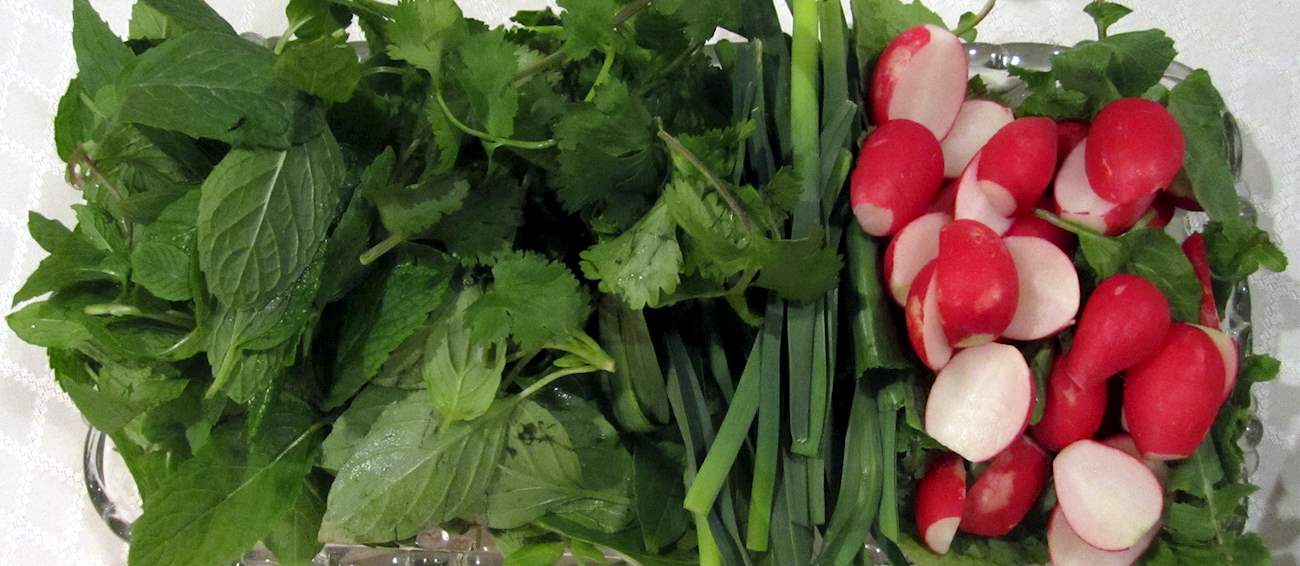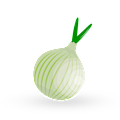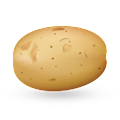Khoresh gheimeh, occasionally called simply gheimeh or gheimeh polo, is a traditional meat stew made with yellow split beans. Traditionally it was always made with cubed beef or lamb, but modern variations sometimes include lean chicken breasts.
Unlike other traditional Iranian stews, the meat in gheimeh is usually cut into tiny cubes. Besides yellow split beans and meat, gheimeh often incorporates tomatoes and onions, all combined with traditional Iranian spices such as turmeric and dried lime.
Sabzi khordan refers to an assortment of fresh herbs and vegetables served as an essential part of most Iranian meals. It usually consists of basil, dill, mint, parsley, radishes, scallions, and a variety of other fresh herbs and vegetables. Traditionally, sabzi khordan is served as a side dish with many Iranian meals, but it can also be enjoyed as an appetizer or a light main meal, when it is typically accompanied by flatbreads and feta cheese.
This flavorful Iranian appetizer combines grilled or oven-roasted eggplants and kashk—a fermented by-product typically made with yogurt whey. The main ingredients are mashed until creamy, with the addition of sautéed onions, garlic, various spices such as turmeric or mint, and occasionally ground nuts.
The dish is garnished with chopped walnuts, mint, and caramelized onions, as well as a small amount of kashk. Kashke bademjan is enjoyed as an appetizer, a dip, or occasionally the main course, and is best served with warm lavash bread on the side.
Mirza Ghassemi is an eggplant specialty that hails from the Gilan province of Iran. The dish is prepared with eggplants that are first grilled or charred on an open flame before they are finely chopped and combined with tomatoes, garlic, and turmeric.
Finally, eggs are added to blend all the ingredients. Mirza Ghassemi can be prepared in a pan, or as a casserole-dish. It was invented by Mohammad Ghasem Khan, who was once the head of the Gilan province and an Iranian ambassador in Russia. This simple but flavorful dish can be enjoyed as an appetizer when it is usually accompanied by flatbread or as a side dish with rice.
Naz khatun is an authentic Iranian vegetable condiment which originated in the city of Behshahr. It is prepared with fire-roasted or oven-roasted eggplants, a rather large amount of herbs, and the unusual verjuice, a zesty drink made from unripe grapes.
Roasted eggplants are roughly or finely chopped, then mixed with fragrant herbs such as mint, basil, and parsley. Traditional versions may also include garlic, pomegranate molasses, and powdered wild celery, also known as angelica. Sour verjuice is added in the end to infuse the ingredients and bind them into a more homogenous paste.
Dal adas is a traditional vegetarian dish hailing from the southern Iranian port city of Bushehr, located on the Persian Gulf. Reminiscent of an Indian dal, this dish typically consists of red lentils which are simmered in vegetable stock with sautéed onions and garlic, diced potatoes, tomato purée, and spices such as turmeric, cumin, cinnamon, chili powder, and salt.
The combination is enhanced with fresh lime juice or tamarind paste, and it can have a thin and soupy or thick and stew-like consistency. This spicy lentil soup or stew is generally served with freshly chopped coriander and red chili on top, and it's usually accompanied by Persian rice or warm bread on the side.
Ash-e jo is a hearty Iranian soup which combines barley and various beans and lentils. It appears in numerous varieties and can be complemented with various vegetables, spices, and fresh herbs. Even though meat is easily incorporated into the soup, it is not a traditional ingredient used in the preparation of ash-e jo.
The soup is characterized by its thick texture and a slightly sour taste provided by freshly squeezed lemon juice and barberries.
Among numerous varieties of Iranian kuku dishes, the eggplant-based kuku bedemjan is one of the classics. Besides eggplants and eggs, it can consist of various other vegetables, fresh herbs, spices, and occasionally chopped walnuts or tangy Iranian barberries.
Just like other kuku dishes, bademjan is traditionally shaped like a thick, round pancake or an omelet that is pan-fried on both sides. It can be served warm or chilled and enjoyed as a quick snack, light main course, or a vegetable side dish.
MAIN INGREDIENTS
Kadoo polo is a traditional Persian dish featuring rice and spiced pumpkin, popular in Caspain Sea region of Iran. Known for its warm, aromatic flavors, it combines basmati rice with tender pumpkin, spices, and often caramelized onions. The pumpkin is peeled, cubed, and sautéed or caramelized to add a subtle sweetness, while onions and garlic create a savory base.
Spices like turmeric, cinnamon, and saffron infuse the dish with a golden color and rich aroma, and sometimes a touch of sugar or honey is added for additional sweetness. To prepare it, the pumpkin and onions are cooked separately with spices, then layered with the rice in a pot and steamed to create the tahdig, a crispy rice crust cherished in Persian cuisine.
TasteAtlas food rankings are based on the ratings of the TasteAtlas audience, with a series of mechanisms that recognize real users and that ignore bot, nationalist or local patriotic ratings, and give additional value to the ratings of users that the system recognizes as knowledgeable. TasteAtlas Rankings should not be seen as the final global conclusion about food. Their purpose is to promote excellent local foods, instill pride in traditional dishes, and arouse curiosity about dishes you haven’t tried.













